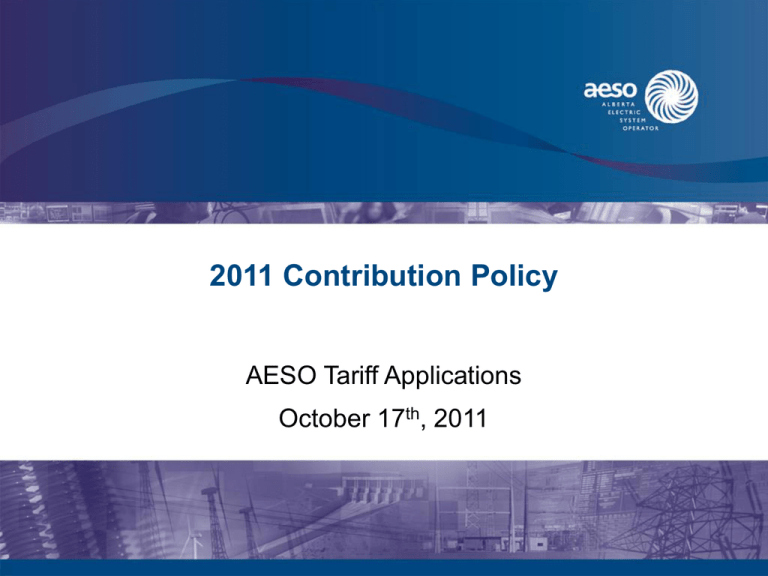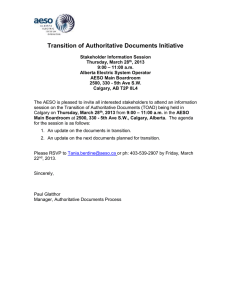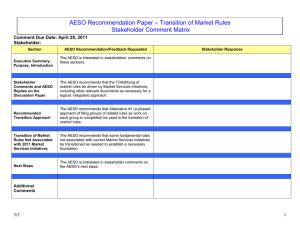2011 Contribution Policy AESO Tariff Applications October 17 , 2011
advertisement

2011 Contribution Policy AESO Tariff Applications October 17th, 2011 Terms of Reference • Terms of Reference – Working group members – Any other topics? 2 Guidelines • Mechanisms used to determine the balance between averaged and MP specific costs – “80 / 20 Rule” • % of customers or % of costs? • Possible variations – The “multiplier” • How to determine the basis – Revenue “test” • Incremental revenue an MP would contribute to AESO fixed costs over contract length – Line length • MP pays for costs over and above a prescribed line length – % of costs covered for every customer • Each MP gets % of costs covered, every MP pays a contribution 3 Guidelines • Are there any other options not identified here? • Can we identify the essential characteristics of a guideline • Assessment criteria – how do we compare and evaluate – Strength of price signal – Robustness, sustainability, administrative ease – Addresses intergenerational equity – Others? 4 Contribution Policy Considerations – AESO 1 • Construction contributions should relate only to the local connection costs for system access service. Deeper system costs are properly the responsibility of all market participants receiving system access service and should be recovered from all market participants through rates for system access service. (Decision 2005-096, page 43) 5 Contribution Policy Considerations – AESO 2 • The underlying purpose of the contribution policy is to send price signals (reflective of the AESO’s economics) to market participants when they are considering siting alternatives for their facilities. (Decision 2005-096, page 43) 6 Contribution Policy Considerations – AESO 3 • An excessive local investment allowance could provide incentives for market participants to pursue higher standards of connection facilities than required and justify doing so on the basis that the cost of the higher standard facilities would not exceed the permitted investment allowance. (Decision 2005-096, page 44) 7 Contribution Policy Considerations – AESO 4 • Because an incremental revenue approach may place undue upward pressure on rates, maximum investment allowances should be below a level representing the incremental revenues expected to arise from the connection of a new system access service. (Decision 2005-096, page 44) 8 Contribution Policy Considerations – AESO 5 • Investment allowances should be set with regard to the anticipated costs of connecting a system access service reflecting acceptable standards of functionality and service established by the AESO. (Decision 2005-096, page 44) 9 Contribution Policy Considerations – AESO 6 • Connection facility service characteristics and standards of functionality may change over time. (Decision 2005-096, page 44) 10 Contribution Policy Considerations – AESO 7 • Cost, not revenue, is the appropriate starting point for establishing the contribution policy. (Decision 2005-096, page 56) 11 Contribution Policy Considerations – AESO 8 • Significant economies of scale occur as the size of connection projects increases, and such economies of scale should be reflected in the functional form of the maximum investment curve. (Decision 2005-096, page 57) 12 Contribution Policy Considerations – AESO 9 • It is still necessary to maintain the dual-use formula (implemented through the substation fraction) to ensure that market participants that are primarily generators are not able to gain an effective exemption from the requirement in the Transmission Regulation that generators are to pay for their local connection costs. (Decision 2005-096, page 61) 13 Contribution Policy Considerations – AESO 10 • The POD cost function used as the basis for the Rate DTS POD charge should be used as the basis for the maximum investment function. (Decision 2007-106, page 92) 14 Contribution Policy Considerations – AESO 11 • Electric distribution system owners and direct-connected market participants should be treated comparably under the contribution policy in the AESO’s tariff. (Decision 2007-106, page 103) 15 Contribution Policy Considerations – AESO 12 • The contribution policy needs to consider minimizing intergenerational inequity 16 Contribution Policy Considerations – AESO 13 • The contribution policy needs to consider that most market participants should not pay a contribution for standard facilities, such that utilities are compensated for the assets they own, operate, and use to provide service (Decision 2010-606, page 80) 17 Contribution Policy Considerations – AltaLink 1 • The Customer Contribution Policy needs to consider economic signals to customers to encourage the best long term economic solution. – The maximum investment level and the required customer contribution will send economic signals to customers. These signals should financially encourage customers to make interconnection decisions that are the most economical (for themselves and the system), while considering the long term transmission plan. 18 Contribution Policy Considerations – AltaLink 2 • The Customer Contribution Policy needs to consider the best long term economic and technical solution to meet standard customer and system requirements. – An interconnection Proposal should consider both the economics of the interconnection proposal (investment and customer contribution) as well as the best technical solution. This should be based on the needs of standard customer and system requirements. This all must be considered in the context of concerns around the environmental and other community issues. 19 Contribution Policy Considerations – AltaLink 3 • The Customer Contribution Policy needs to consider that technical interconnection solutions and current interconnection costs drive the investment levels, not vice versa. – Costs to interconnect customers will fluctuate as the market for materials and labour varies. Depending on the technical details of the interconnection and the fluctuating costs the investment level should vary correspondingly. In addition, the contribution formula should not lead to sub-optimal technical solutions. 20 Contribution Policy Considerations – AltaLink 4 • The Customer Contribution Policy needs to consider current utility standards of service, and that standards may change over time. – Utility standards vary over time and the investment level, and therefore the customer contribution, should vary to match those varying standards. 21 Contribution Policy Considerations – AltaLink 5 • The Customer Contribution Policy needs to consider minimizing intergenerational inequity. – Recognizing cost inflation, the maximum investment and therefore the customer contribution, should strive to be fair between customers of different vintages. To the extent possible, new customers, or customers increasing their service level, should not proportionately pay any more, or less, then customers who have been on the system for a period of time. 22 Contribution Policy Considerations – AltaLink 6 • The Customer Contribution Policy needs to consider harmonization among utilities (including the AESO) to ensure a consistent approach and treatment for all customers. – In order to maintain equity, customers in different jurisdictions, or served at the transmission or distribution levels, should be treated fairly. Given that the tariffs may be different, the maximum investment calculation may not be identical. As well, aligning utility investment levels with the AESO’s investment level will help to minimize customer confusion and sub‐optimal system development. 23 Contribution Policy Considerations – AltaLink 7 • The Customer Contribution Policy needs to consider incremental revenue from interconnection of new customers compared to the cost to serve them. – As new customers interconnect to the AIES they will provide incremental revenue to the utility serving them. This revenue should be compared to the costs to interconnect them. 24 Contribution Policy Considerations – AltaLink 8 • The Customer Contribution Policy needs to consider most customers should not pay a contribution for standard facilities. In this way, utilities would be compensated for the assets that they own, operate, and use to provide service. – Historically, policy in Alberta has supported postage stamp rates wherein transmission load customers with reasonable interconnection costs do not pay up‐front costs to interconnect to the AIES. Reasonable interconnection costs are recovered from customers, via tariffs, over the life of their connection to the system. This results in utilities being compensated for owning and operating assets that they utilize to serve customers. This principle has been largely met in some tariffs by applying the “80/20 rule.” 25 Contribution Policy Considerations – AltaLink 9 • The Customer Contribution Policy needs to consider that the methodology should be simple to administer and applied in a consistent and transparent manner. The more simple, consistent and transparent the investment policy is, the easier it will be for 26 Contribution Policy Considerations – Fortis 1 • MILs should be set to achieve a reasonable balance of what an individual customer pays upfront through a customer contribution versus what all customers in a particular rate class pay through ongoing rates. In other words, new customers should receive a fair and sufficient level of investment such that the majority of customers do not pay contributions for connecting, while still ensuring that existing customers are not unduly burdened by the cost of such new services 27 Contribution Policy Considerations – Fortis 2 • MILs should provide economic discipline and price signals to new customers as they are connected to the interconnected transmission and distribution system, and these levels should be aligned with encouraging the best long term economic and technical solution to meet standard service requirements 28 Contribution Policy Considerations – Fortis 3 • The maximum amounts that the company invests in a new extension on behalf of all customers should consider the expected longevity or any other risks associated with the new service 29 Contribution Policy Considerations – Fortis 4 • The current cost to connect new customers is the appropriate starting point for establishing MILs 30 Contribution Policy Considerations – Fortis 5 • Setting of MILs needs to respect each utility’s standards of service, while recognizing that these standards and the associated costs will change over time 31 Contribution Policy Considerations – Fortis 6 • Changes to MILs should balance the need to attain the target MILs over a reasonable timeframe, while ensuring there is not undue upward pressure on tariff rates 32 Contribution Policy Considerations – Fortis 7 • Adjustments to MILs should consider minimizing intergenerational inequity and cross-subsidy, whereby the portion of the cost of an extension that the company invests in should be in similar proportion with previously established investment levels. Both new and existing customers should be treated similarly to the extent possible and should see a similar price signal when the system is or was extended to provide service 33 Contribution Policy Considerations – Fortis 8 • To the extent practical, the structure of MILs (ex. fixed dollar amount, or $/unit) should generally align with cost causation and the rate structure which is applied to the customer 34 Contribution Policy Considerations – Fortis 9 • MILs should be simple to administer and applied in a consistent and transparent manner 35 Contribution Policy Considerations – Fortis 10 • Utilities should take into consideration the approaches of neighbouring utilities when developing MILs. In a reasonable timeframe, individual company’s MILs should move towards an AUC-adopted, common approach to setting investment levels for Alberta utilities 36 Next steps • Contribution Data – What kind of data do we need to see – Discuss the value of the “extra 18” data points • Consultant? • Next meeting – Thursday, November 17th 37 Schedule Working Group meeting #2 November 17 2011 Working Group meeting #3 December 12 2011 Working Group meeting #4 January 5 2012 Working Group meeting #5 January 30 2012 Working Group meeting #6 February 20 2012 Working Group meeting #7 If required 38 Thank you


